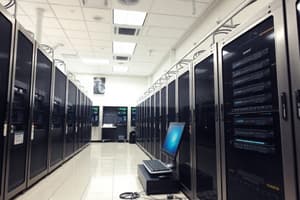Podcast
Questions and Answers
What defines an open system in the context of computing?
What defines an open system in the context of computing?
- It has a hierarchical structure without any interactions.
- It can receive and produce data, interacting with its environment. (correct)
- It is isolated from its environment with no inputs or outputs.
- It operates with fixed components that cannot be modified.
Which characteristic describes the speed of a computer?
Which characteristic describes the speed of a computer?
- It is always slower than manual calculations.
- It was designed to perform calculations at high speeds. (correct)
- It can only perform calculations on small data volumes.
- It has limited capabilities in mathematical operations.
What is indicated by the term 'accuracy' in the context of computer operations?
What is indicated by the term 'accuracy' in the context of computer operations?
- Input errors predominantly lead to inaccurate output.
- High accuracy is achieved through advanced error-detecting techniques. (correct)
- Computers occasionally produce false results due to inherent errors.
- The consistency of results can vary with different machines.
Which of the following best describes the storage capability of a computer?
Which of the following best describes the storage capability of a computer?
In a computing context, what is the purpose of the data processing concept represented as 'input - process - output'?
In a computing context, what is the purpose of the data processing concept represented as 'input - process - output'?
What is a characteristic of a closed system?
What is a characteristic of a closed system?
Which of the following statements about errors in computer systems is accurate?
Which of the following statements about errors in computer systems is accurate?
What is a key feature of the system components in a computer?
What is a key feature of the system components in a computer?
What was a significant change introduced with the development of computers in the 1980s?
What was a significant change introduced with the development of computers in the 1980s?
Who was chiefly responsible for the design and construction of the ENIAC?
Who was chiefly responsible for the design and construction of the ENIAC?
What primary technology was used in the first generation of computers?
What primary technology was used in the first generation of computers?
What type of computer is designed to manage daily operations for large enterprises?
What type of computer is designed to manage daily operations for large enterprises?
What was one method of input used in the first generation of computers?
What was one method of input used in the first generation of computers?
Which mathematician is recognized as a crucial figure in the history of computing?
Which mathematician is recognized as a crucial figure in the history of computing?
What characterizes the processing power of Super Computers?
What characterizes the processing power of Super Computers?
Which of the following generations of computers primarily utilized machine language?
Which of the following generations of computers primarily utilized machine language?
Who is recognized as the 'Father of the Computer'?
Who is recognized as the 'Father of the Computer'?
What invention is Joseph Marie Jacquard best known for?
What invention is Joseph Marie Jacquard best known for?
Which computer was the first to be designed with the concept of storing programs in memory?
Which computer was the first to be designed with the concept of storing programs in memory?
What significant contribution did Augusta Ada Byron make to computer science?
What significant contribution did Augusta Ada Byron make to computer science?
Which of the following mathematicians invented the Pascaline?
Which of the following mathematicians invented the Pascaline?
What is the significance of ENIAC in computing history?
What is the significance of ENIAC in computing history?
Which individual is credited with the invention of the Stepped Reckoner?
Which individual is credited with the invention of the Stepped Reckoner?
Which invention is Charles Xavier Thomas de Colmar best known for?
Which invention is Charles Xavier Thomas de Colmar best known for?
What does the origination step in the data processing cycle refer to?
What does the origination step in the data processing cycle refer to?
What is a primary limitation of a computer?
What is a primary limitation of a computer?
Which of the following correctly describes the output preparation phase?
Which of the following correctly describes the output preparation phase?
What capability allows computers to perform automatic operations and detect errors?
What capability allows computers to perform automatic operations and detect errors?
In what way do computers outperform humans in tasks?
In what way do computers outperform humans in tasks?
What type of operations can computers perform aside from mathematical calculations?
What type of operations can computers perform aside from mathematical calculations?
What does the processing step entail in the data processing cycle?
What does the processing step entail in the data processing cycle?
Which of the following is NOT a capability of a computer?
Which of the following is NOT a capability of a computer?
What was the primary function of the tally stick?
What was the primary function of the tally stick?
Who invented the stepped reckoner?
Who invented the stepped reckoner?
Which device was developed primarily for automatic weaving?
Which device was developed primarily for automatic weaving?
Which ancient tool is primarily used for arithmetic operations?
Which ancient tool is primarily used for arithmetic operations?
What was the first commercially successful mechanical calculator?
What was the first commercially successful mechanical calculator?
What did Napier's Bone simplify for calculations?
What did Napier's Bone simplify for calculations?
When was the slide rule developed?
When was the slide rule developed?
Which of the following describes a punch card?
Which of the following describes a punch card?
Flashcards are hidden until you start studying
Study Notes
Computer System Overview
- An electronic data processing machine capable of mathematical and logical operations, processing large volumes of data rapidly.
- A system consists of organized, interdependent components that interact to achieve predetermined goals.
Characteristics of a Computer
- Speed: Initially invented as a high-speed calculator; can add two 18-digit numbers in 300 to 400 nanoseconds.
- Accuracy: Consistently high accuracy, although errors can occur due to machinery; advanced error detection minimizes false results.
- Storage: Can store large amounts of data permanently, including text, graphics, audio, and video files. Storage capacity is increasing rapidly.
Types of Systems
- Closed System: No input or output; isolated from its environment.
- Open System: Has inputs and outputs, interacting with the environment.
Data Processing Cycle
- Consists of origination, input preparation, processing, output preparation, and storage.
- Represents the flow of data from recording to usable information.
Evolution of Computers
- Tally Stick: Used for recording quantities and messages (40,000 - 10,000 years).
- Abacus: Ancient calculating tool (2700-2300 BC) from various cultures.
- Stepped Reckoner (1672): Mechanical calculator by Leibniz, capable of basic arithmetic.
- Jacquard Loom (1804): Introduced punched cards for automatic weaving.
- Napier's Bones (1617): A device for simplifying multiplication and division.
- Slide Rule (1622): Mechanical analog computer for complex calculations.
- Arithmometer (1850-1851): First commercially successful mechanical calculator by Charles de Colmar.
- UNIVAC 1: The first commercial computer in the U.S., designed by Eckert and Mauchly.
- EDVAC (1952): One of the earliest electronic computers, the first stored program computer developed by von Neumann.
Key Figures in Computer Science
- Charles Babbage: Often referred to as the "Father of the Computer," known for the Analytical Engine.
- Augusta Ada Byron: Recognized as a pioneer in computer science for her work with Babbage.
- John von Neumann: Essential figure in computing, known for the architecture that underlies most computers today.
Generations of Computers by Size
- First Generation (mid-1940s to late 1950s): Vacuum tubes and punch cards for input.
- Supercomputers: High performance for research.
- Mainframe Computers: Used by large enterprises for data management.
Computer Capabilities
- Ability to perform logic operations and complex calculations.
- Capable of accurate data storage and retrieval.
- Performs automatic operations and error detection.
Limitations of Computers
- Dependence on programmed instructions; they do only what they are programmed to do.
Studying That Suits You
Use AI to generate personalized quizzes and flashcards to suit your learning preferences.




